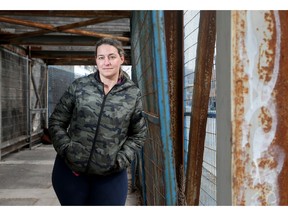Rideau-Vanier Coun. Stéphanie Plante wants to help residents navigate getting action on buildings that have become perpetual problems in their neighbourhood.
Article content
Squatters moving into derelict buildings. Arson. Overdoses. Sex trafficking. Violence. Discarded syringes. Backyard encampments. Vacant lots filled with weeds and trash.
Members of Ottawa community groups delivered a litany of horrors associated with “problematic properties” to a city committee last week. They also supported the introduction of an online toolkit to help residents navigate around getting action on buildings that have become perpetual problems in their neighbourhoods.
Advertisement 2
Article content
Article content
Speaking for Action Sandy Hill, a local community association, Jerald Sabin told councillors about a property in the neighbourhood, 302-306 Besserer Street, where buildings have been unoccupied since at least 2022 and there have been numerous calls to fire and ambulance.
At least two firefighters have fallen through the floor when attending a fire, Sabin told councillors. It took a “Herculean push” from residents to get the property owner to put a fence around the property.
“This is important because such buildings give the impression that people don’t care for about our neighbourhood,” he said. “It gives the idea that the neighbourhood is unsafe, unloved and dumping ground for the city’s problems.”
Creating a page on the city’s website is a first step to managing problematic properties, argues Rideau-Vanier Coun. Stéphanie Plante. She has proposed a page with links to walk residents through the process of making a complaint, listing who is responsible for what and how to follow up.
“I want people to come here and invest. We need better tools to manage this,” she said.
Advertisement 3
Article content
Last week, Plante got the support of the city’s emergency preparedness and protective services committee.
“I think it would be a great resource, rather than me telling people ‘Go to by-law for this and to the police for that,’ ” said Cheryl Parrott, chair of the security committee at the Hintonburg Community Association.
About 60 problematic buildings have been identified in Hintonburg, said Parrott. After the tenants of one building were evicted, the property became the target for break-ins. Eventually, the building was full of syringes, she told councillors. The building was demolished in July 2023, but the empty lot is still full of weeds and trash, she said.
Chris Greenshields, a member of the Vanier Community Association, said residents are frustrated by the lack of progress. “By-law officers are often limited to citations and fines,” he said.
Parrott argues that the responsibility needs to be shifted to property owners who fail to secure their properties.
Edmonton has created a new higher property tax subclass for problem properties to recoup some of the cost otherwise put on taxpayers. The Alberta city was the first in Canada to adopt a special tax on uninhabitable homes to incentivize owners to repair them. Edmonton has recently assessed 203 homes as derelict.
Advertisement 4
Article content
“Ottawa needs to look at this as a further step,” said Parrott. “There is a cost to the community and all of us who pay taxes.”
Councillors also have concerns about problematic buildings. Somerset ward Coun. Ariel Troster said there are unsafe buildings in her ward occupied by squatters.
“At least one woman died during the heat wave last summer due to heat due to heat exhaustion,” she told fellow councillors.
John Dickie, chair of the Eastern Ontario Landlords Association, said he supported Plante’s initiative — but from a different perspective.
Demolishing a property is prohibited unless there is a building permit in hand to build a new property, said Dickie. It can take a long time to get development approvals. Financing conditions can change.
“I don’t like looking at these unsightly properties either,” he said. “Yes, we should deal with them, but we have to deal with them intelligently. And we should get at the root of the problem, which I would suggest to you is this demolition control in inner urban areas.”
The first part of the exercise will be to come up with a definition of what is — and what is not — a problematic property, to avoid vexatious or frivolous complaints.
Advertisement 5
Article content
The problem is not occasional student keg parties, but properties that are in disrepair and attract criminality, said Sabin. “We need to be able to define the problem.”
It’s too soon to say what might be on the web page, but it should have links to city departments involved with problematic properties, both occupied and unoccupied, and to 3-1-1, the city’s help and complaints line, said Plante. It should also have a “map” of the process and timelines to let residents know how long they can expect each step to take.
Plante also wants the page to have links to provincial legislation, such as the Property Standards Act because the city does not have sole responsibility, she said.
“I love the idea of bringing the province into the fold to talk about solutions.”
Article content


